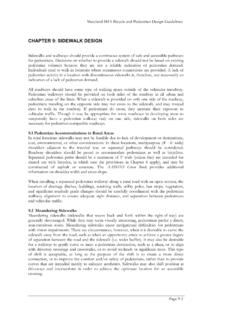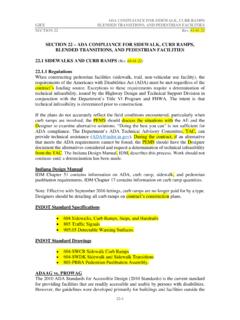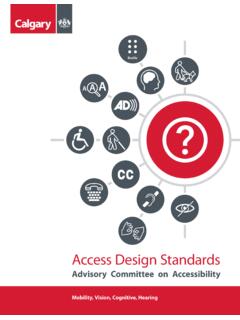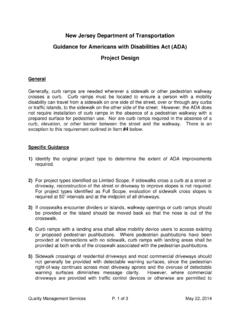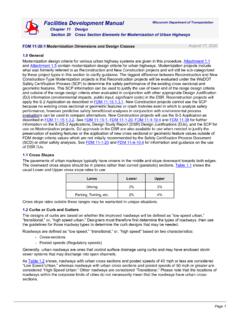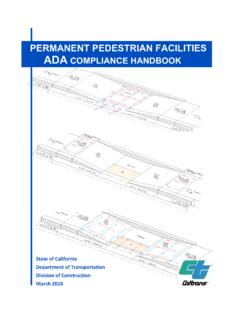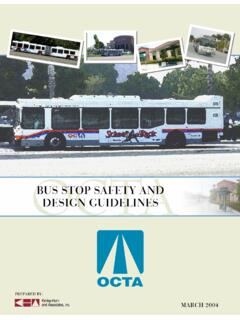Transcription of CHAPTER 9: SIDEWALK DESIGN - Maryland.gov Enterprise ...
1 Maryland SHA Bicycle and Pedestrian DESIGN Guidelines Page 9-1 CHAPTER 9: SIDEWALK DESIGN Sidewalks and walkways should provide a continuous system of safe and accessible pathways for pedestrians. Decisions on whether to provide a SIDEWALK should not be based on existing pedestrian volumes because they are not a reliable indication of pedestrian demand. Individuals tend to walk in locations where continuous connections are provided. A lack of pedestrian activity in a location with discontinuous sidewalks is, therefore, not necessarily an indication of a lack of pedestrian demand. All roadways should have some type of walking space outside of the vehicular travelway.
2 Pedestrian walkways should be provided on both sides of the roadway in all urban and suburban areas of the State. When a SIDEWALK is provided on only one side of the roadway, pedestrians traveling on the opposite side may not cross to the SIDEWALK , and may instead elect to walk in the roadway. If pedestrians do cross, they increase their exposure to vehicular traffic. Though it may be appropriate for some roadways in developing areas to temporarily have a pedestrian walkway only on one side, sidewalks on both sides are necessary for pedestrian-compatible roadways. Pedestrian Accommodations in Rural Areas In rural locations sidewalks may not be feasible due to lack of development or destinations, cost, environmental, or other considerations.
3 In these locations, multipurpose (4 - 6 wide) shoulders adjacent to the traveled way or separated pathways should be considered. Roadway shoulders should be paved to accommodate pedestrians as well as bicyclists. Separated pedestrian paths should be a minimum of 5 wide (unless they are intended for shared use with bicycles, in which case the provisions in CHAPTER 6 apply), and may be constructed of asphalt or concrete. The AASHTO Green Book provides additional information on shoulder width and cross-slope. When installing a separated pedestrian walkway along a rural road with an open section, the location of drainage ditches, buildings, retaining walls, utility poles, bus stops, vegetation, and significant roadside grade changes should be carefully coordinated with the pedestrian walkway alignment to ensure adequate sight distance, and separation between pedestrians and vehicular traffic.
4 Meandering Sidewalks Meandering sidewalks (sidewalks that weave back and forth within the right-of-way) are generally discouraged. While they may seem visually interesting, pedestrians prefer a direct, non-circuitous route. Meandering sidewalks cause navigational difficulties for pedestrians with vision impairments. There are circumstances, however, when it is desirable to curve the SIDEWALK away from the road, such as when an opportunity arises to achieve a greater degree of separation between the road and the SIDEWALK ( wider buffer). It may also be desirable for a walkway to gently curve to meet a pedestrian destination, such as a plaza, or to align with driveway crossings and crosswalks, or to avoid wetlands or significant trees.
5 This type of shift is acceptable, as long as the purpose of the shift is to create a more direct connection, or to improve the comfort and/or safety of pedestrians, rather than to provide curves that are intended merely to enhance aesthetics. Sidewalks may also shift position at driveways and intersections in order to achieve the optimum location for an accessible crossing. Maryland SHA Bicycle and Pedestrian DESIGN Guidelines Page 9-2 SIDEWALK DESIGN Figure shows guidelines for the DESIGN of sidewalks, including width and cross slopes. SIDEWALK Buffer Zone A pedestrian s safety and comfort in the roadway environment is largely dependent on the width and quality of the buffer between the SIDEWALK and the roadway.
6 Physical barriers between the SIDEWALK and roadway (such as street trees, landscaping, bike lanes and parked cars) will increase pedestrian safety and comfort, and therefore encourage higher levels of parking has a very positive effect on pedestrian comfort. Along some arterial and collector streets in areas that are seeking to enhance and/or introduce a traditional commercial core (with stores/businesses in front and parking lots behind), it may be feasible to add on-street parking tree species for SHA rights-of-way and public easements are listed in the Roadside Tree Law Recommended Tree List. For narrow landscape buffers less than 5 feet wide, care should be taken to use shade tree species that can survive in a narrower space and have less invasive root systems, such as varieties of maple and oak trees.
7 Large shade trees are preferred to medium and small trees that do not offer as much shade. Street trees should typically be placed no closer than 30 feet on center, and no greater than 60 feet on center, depending on the species of tree. In locations with no buffer strip, consideration can be given to providing tree planting behind the SIDEWALK , which may improve aesthetic conditions and provide shade, but will not improve pedestrians sense of safety in the roadway environment. Planting trees behind the SIDEWALK should not be done in new developments or retrofits (such as a road diet) where there is room for a buffered planting strip.
8 Street trees should not be positioned so as to block sight distances at intersections and retrofit locations where the SIDEWALK is unavoidably placed adjacent to the curb , an additional 2-feet of SIDEWALK width should be provided. Sidewalks placed directly adjacent to retaining walls or other vertical obstructions should also be increased in width by 2-feet. curb ramp DESIGN For guidance on curb ramps and other accessibility issues, refer to SHA s Accessibility Policy & Guidelines for Pedestrian Facilities along State Highways. In the past, some engineers have denied requests for curb ramps in an effort to discourage crossing at uncontrolled legs of intersections.
9 Pedestrians have a legal right to cross the roadway at uncontrolled crosswalks and when curb ramps are not provided at legal crossings, some pedestrians are physically unable to do so. For this reason, it is necessary to provide curb ramps at uncontrolled locations (such as T intersections) as well as conventional four-legged intersections. curb ramps are also needed at the ends of sidewalks where they do not terminate at an intersection, so that pedestrians can safely access the roadway shoulder. Figure - Example of a Great SidewalkFigure - Example: of a SIDEWALK with Buffer Zone Maryland SHA Bicycle and Pedestrian DESIGN Guidelines Page 9-4 Figure - Example of a Continuous Pedestrian Route over a Depressed curb Entrance where there is a Buffer between the SIDEWALK and the curb (An example application of Standard No.)
10 Handrails on Sidewalks Handrails are required when the through pedestrian zone is adjacent to a vertical drop of or more. Sidewalks with running slopes less than or equal to the slopes of the adjacent roadway are not considered ramps, even when they are at grades greater than 5%. As a result, they are exempt from the requirements for running slope in the Americans with Disabilities Act, including the requirements for SIDEWALK DESIGN on Bifurcated Roadways For the purpose of this document, a bifurcated roadway is one where the sidewalks are raised above or set below the elevation of the roadway. Bifurcation is typically used in environmentally sensitive areas or hilly terrain and is often accomplished with the use of roadside barriers and small retaining walls.
